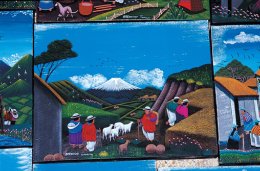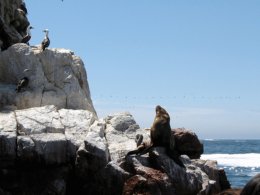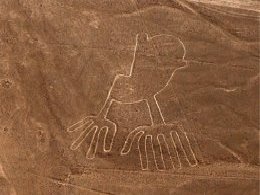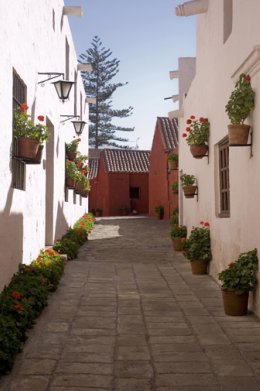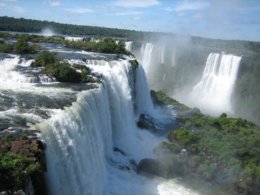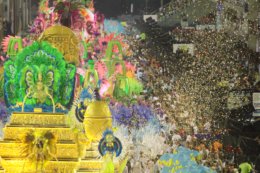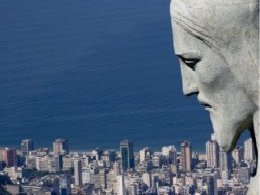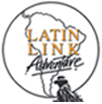El Grande
Day 1 - Thurs: Quito
Arrive Quito. On arrival you will be met and transferred to your hotel.
Day 2 - Fri: Quito (B)
The morning is at leisure. In the afternoon we undertake a scenic tour of Quito, the capital of Ecuador, taking you through its wealth of culture, history and tradition. We end up at a lookout point with great scenic view.
Day 3 - Sat: Otavalo (B/L)
On our third day, we take a full day excursion to Otavalo. This excursion goes north to the land of the Otavaleños and South America's most famous Indian fair.
Day 4 - Sun: Quito - Galapagos (B/L/D)
You will be transferred to the airport for your flight to Galapagos (please note there is a USD10 immigration fee payable on arrival).
One of the world's greatest treasures of natural history lies in the bewitching Galapagos Islands, famed for its fearless and unique wildlife, and is the highlight of most trips to Ecuador.
The Galapagos Islands have been named after the giant Galapagos Tortoises. The archipelago, 1000km (600 miles) off Ecuador's Pacific Coast originated from undersea volcanic activity, six million years ago. The archipelago's 13 major islands, 6 smaller ones, and scores of islets are all part of Ecuador's National Park system.
In 1835, the English naturalist Charles Darwin visited the islands and discovered this "living laboratory" which inspired his writings on the Theory of Evolution. Many of the animals on the Galapagos Islands have developed into different species from their continental relatives, and because they have never experienced man as a predator, they show no fear of humans. The world's most wondrous group of islands is yours for an unhurried exploration. Follow the nature trails, enjoy the amazing sights, wade and even dive among the animals of land and sea.
The sixteen passenger “ Aida Maria “offers a great combination of comfort, style and economy for tours in the Galapagos. Each of the eight cabins has a private bath and hot shower, air conditioning and an ample external deck to enjoy the sunny Galapagos days. Its design is based on efficiency and comfort with ample social areas and 8 cabins - 2 on main deck, 2 on the upper deck and 2 in solarium providing optimum comfort for your experience exploring the Galapagos.
- All meals and shore excursions are included.
- Your accommodation is in 2 berth cabins.
- Please note a Galapagos National park fee of USD100 is to be paid in cash on joining the cruise.
As you prepare to land in Baltra, peer out the window. The landscape below will seem out of this world - a place like no other. The Galapagos Islands are unique to the world and you are about to see why.
Your bilingual naturalist guide will greet you at the airport and assist you through customs. During lunch he/she will introduce you to the islands and specifically the flora and fauna you will encounter at our first destination, Las Bachas Beach. On the sandy white beaches of Las Bachas we will get a close look at a sea turtle nesting area and a lake frequented by leggy pink flamingos and other migratory birds. Afterward, we cool ourselves off with our first dip in the deliciously blue Pacific Ocean.
As this is our first evening together, the crew will invite us to a pre-dinner cocktail on the yacht before the welcome dinner. If the night is clear, as it usually is, the stars above will bedazzle; look for the Southern Cross, the Big Dipper and Orion.
Day 5 - Mon: Genovesa Island (B/L/D)
Early in the morning we have breakfast before disembarking at the Genovesa (Tower) Island located in the northeast portion of the Galapagos (less than half a degree north of the equator). Tower is an outpost for many sea birds (as Española is in the south). Interestingly, there are no land reptiles on Tower, only very small marine iguanas. This is attributed to the direction of the ocean currents, which evidently wouldn’t have carried the terrestrial animals here. We'll visit El Barranco during the morning then return to the boat for lunch, and later cruise to Darwin Bay.
The anchorage at Darwin Bay, located on the southern portion of the island, is actually the caldera of an extinct, partially-eroded volcano, with the surrounding cliffs forming the inner portion of the rim. While the origin of the name Tower is not known, one can imagine it had something to do with the towering cliffs. The tour will be a long, fairly easy walk, but it is usually hot and dry here, so you may want to carry some water. After a wet landing on a coral beach, the trail begins in an area where there are several swallow-tailed gulls. As you walk back from the beach, there is a mixture of Opuntia cactus and mangroves.
Day 6 - Tues: Bartolome Island (B/L/D)
Bartolome Island, at its highest point of 114m, has one of the most photographed vistas in the archipelago. This island is quite young and volcanic. Therefore, it's relatively unpopulated; only a small handful of die-hard plant and animal species have survived long enough to call this lava-land home.
After our visit to Bartolome island we will visit nearby Sullivan Bay. At the turn of the century a huge lava flow spilled forth and right down to the sea; today you can stroll across this black volcanic expanse admiring its time-frozen ripples, bubbles and ropes.
After lunch we will have a short navigation to Chinese hat or Sombrero Chino, a small volcanic cone by the coast of James Island. Sombrero Chino has a beautiful beach for snorkeling with sea lions, as well as a small trail along the coast of this cone where we can spot lots of coast life and shore birds.
Day 7 - Wed: Daphne Island - Santa Cruz (B/L/D)
Early in the morning we arrive at Daphne Island, a tuff cone formed by the accumulation of volcanic ash, which is home to thousands of birds such as blue footed boobies, frigate birds, tropic birds and many more.We will not go ashore but we will navigate around this volcanic cone - binoculars are recommended to get a good look at the birds. Daphne has been a great research site on which many scientists have spent years studying the behavior of Darwin’s finches.
After this visit we move on to our next site, Black Turtle Cove - a red mangrove lagoon on Santa Cruz which is a nursery for many sharks and rays. It is also a great location to observe mating turtles around this time of year. We will hopefully see large groups of resting white-tip reef sharks, schools of golden rays and spotted eagle rays, and a few juvenile scalloped hammerhead sharks and black-tip sharks. The water is nearly mirror-calm and we often used paddles instead of the loud panga engines to move around the area.
After lunch we will navigate for a couple of hours to Cerro Dragon, where we have a dry landing on lava rocks. Cerro Dragon is a small bay on the west coast of Santa Cruz and got its name from the many land iguanas that live in the area. Land iguanas are endemic to the Galapagos islands and have made this place a good mating and nesting area.
Day 8 - Thurs: Santa Cruz (B/L/D)
Here we can find small tortoise, hand-sized between the ages of one and five, and marvel at how they grow to a large size as adults (500lbs or more!). Galapagos tortoises are believed to have a lifespan of over 100 years, so the young ones have a long life ahead of them as long as they receive the protection they need. Aside from the Station headquarters, Santa Cruz boasts the largest town and economic center of the Galapagos, Puerto Ayora. In this port-side town we can buy souvenirs of the islands (postcards, t-shirts, books, etc.). Check-out the uniquely Galapaganean ceramic shop near the entrance of the Charles Darwin Station.
After shopping in Puerto Ayora and lunch on the boat (you may dine in town if you desire), we will explore the upper region ('parte alta') of the island, a moisture-rich area with fertile volcanic soils. We will learn about the vegetation and animal life of this zone, often strikingly different than that found at lower elevations.
Darwin finches, yellow warblers, and bright red vermillion fly catchers will flit in and out of the moss-covered trees. From this high vantage point we are treated to beautiful views of the surrounding archipeliago. In the late afternoon we return to town.
Day 9 - Fri: Floreana Island (B/L/D)
Today when you awake and peer out your porthole you will see Floreana, one of the greenest islands in the archipelago. Ask your guide to tell you about its mysterious history laden with rumors of witches, murderous baronesses, blackmail and dubious disappearances.
Our first stop is Punta Cormorant, where we follow a footpath to a lagoon inhabited by flaming-pink flamingos. We will also pass by Carolina Beach, a sea turtle nesting area and a superb spot for watching sea birds and sea rays.
Back on our yacht, we skirt the island’s coast until we arrive at La Corona del Diablo (the Devil’s Crown), a sub-marine crater that offers some of the most spectacular snorkeling in the Galapagos. This is a great spot for seeing the wide array of tropical fish endemic to the islands as well as purple sea stars and spiky sea urchins. The crater’s most thrilling undersea creatures, however, are the white-tipped sharks. As with most of the creatures in the Galapagos they are unperturbed by your presence, so you can swim in their company freely and without fear.
After returning to the boat for lunch we will sail on to Post Office Bay, where the island’s original post office - really only a wooden barrel - was established in 1793. The current system still functions as it did three centuries ago; Visitors drop off unstamped letters and postcards AND pick-up whatever mail they can hand deliver themselves when they return home! (Try it, it actually works!).
Day 10 - Sat: Espanola Island (B/L/D)
Espanola is one of the most magical of all the Islands. It is a place where the animals reign supreme and we humans, are merely guests. As your dingy brings you to shore you will see sea lion pups sunbathing with marine iguanas and blue footed boobies nesting in between. Nearby may be a Galapagos Hawk. If it is boobie mating season watch the bonded pairs do the infamous boobie dance (if it’s not mating season ask your guide to demonstrate - after all it’s his job to teach you about the local fauna).
As we follow the foot path around the island, we will pass hundreds of boobie nesting sites including one colony of masked boobies. There is a good chance we will see the thief-like frigate bird (which has the habit of stealing other birds’ food), as well as the stunning red-billed tropic bird and the nocturnal swallow-tailed gull. If it is the right time of the year (mid-April to December) we will also encounter the giant waved albatross. Apart from a few pairs that breed on Isla de Plata off the Ecuadorian mainland, all of the world’s 12,000 waved albatross breed on Espanola Island. At the end of the breeding season, the entire population leaves the island and heads out to sea, where they spend years without touching land. Astonishingly, four or five years may pass before the fledglings return to Espanola.
As we make our way around the island we pass by El Soplador, a giant blowhole that explodes to heights reaching 70 feet. In nearby tide pools you can often find lounging sea lions enjoying the blowhole’s misty spray. Following lunch on board the yacht, we will visit Garner Bay, a great place for sunbathing, swimming and snorkeling. Lion fish, flycatchers, and Galapagos hawks will keep us company as we relax under the rays of the evening sun. Dinner on the yacht completes our day.
Day 11 - Sun: Galapagos - Quito (B)
On our 8th day of visiting the Galapagos (Day 11 of the tour) we will arrive early in the morning to San Cristobal, the capital of Galapagos. Our first site will be Kicker Rock or Leon Dormido, a tuff volcanic cone which has been eroded by the wind and marine currents, giving it the shape from the distance of a sleeping sea lion. Now it is home to blue footer boobies and frigate bird which have made of this their nesting site. fter navigating around Kicker Rock we continue on our way to Isla Lobos.
A very small island made of volcanic rocks on which we will disembark, Isla Lobos gets its name from a small colony of sea lions (lobo de mar in Spanish) where we can observe the behavior and interaction of sea lions living in a small community.
Following the visit to Isla lobos we head to Puerto Baquerizo Moreno, the main town in San Cristobal where the airport is located. Before taking the airplane back to the mainland you will have some time to visit the town on your own for some last minute shopping or just getting to see how people live in the Galapagos. We'll return by air to Quito and transfer to our hotel.
Day 12 - Mon: Quito - Patate (B/D)
The artisans tradition of Quito is present in the visit to the Yanapi Hat Shop, where guests can observe the process of making hats by hand, of wool felt and fur felt. These high-quality hats are exported to European, Australian and American markets.
Along valleys and mountains, we'll arrive at Cotopaxi National Park which surrounds the magnificent Cotopaxi Volcano for an up-close view of the Andean paramo habitat and its unique flora and fauna. A number of high-altitude birds can be observed around Limpiopungo Lagoon, and occasionally, wild horses. On clear days the perfect snow-capped cone of the Cotopaxi Volcano is quite a sight!
From here we descend towards the town of Patate to spend the night at a 300-year old hacienda. Hidden among the mountains, a magical ambience where the afternoon mist descends is present, stories are told about those who left in search of the treasure of the Incas in the nearby Llanganatis - and never returned.
Day 13 - Tues: Patate - Riobamba (B/D)
After breakfast, we take a spectacular route along the gorge of the Pastaza River to the town of Baños (Baths), right at the foot of Tungurahua Volcano where the thermal waters that gave it its name emerge. We drive along the Route of the Cascades to El Pailón del Diablo (the Devil's Cauldron) - the most adventurous of us will descend (medium difficulty) to observe the impressive cascade up close, surrounded by subtropical vegetation and orchids. The force and sound of the waters can also be appreciated from a lookout point without descending.
In the afternoon we can take a short stroll along Baños - a town with an international pulse. It is full of people from all over the world as well as many locals who pilgrimage to the Sanctuary of the Virgin of Holy Water.
From here, the route to Riobamba is up the mountain (to where the clouds can be touched). Alongside the massive Chimborazo, the highest mountain of Ecuador, on the high paramo where vicuñas graze and scamper - this is a protected Faunistic Preserve. On the hillsides, where the land is worked beneath the plow, one might think the farmer's true objective was to paint the hills in fascinating patterns, not just to the dark, fertile soil. Great photo ops on this route!
We arrive in Riobamba just in time for dinner.
Day 14 - Wed: Riobamba - Cuenca (B/L)
A busy day today. After an early breakfast, we depart by road, skirting the flanks of the Andes, with an astonishing ride - twisting and turning, along bridging ravines and river gorges. We'll ride through Indian villages and cultivated fields; here is where most of the cereals in Ecuador are grown, among them, the quinua, considered the perfect grain for its nutritional value.
After about 2 hours arrive at the small town of Alausí, the beating heart of the rehabilitation of the Ecuadorian Railway Company in the last years. We continue exploring the Andean world by motorcoach to the south, visiting the Inca Fortress of Ingapirca en-route with lunch in the area. We arrive in Cuenca at dusk for dinner and our accommodation.
Day 15 - Thurs: Cuenca (B/L)
Cuenca is Ecuador's third largest city, yet it still retains its pleasant provincial air. Its red tiled roofs, cobblestone streets, flowery plazas and museums make it very special. This comprehensive visit includes the Plaza of San Sebastian, a colorful artisans market, where handicrafts are sold. Thenon to a visit of the Museum of Modern Art, featuring an excellent collection of contemporary fine art. Next is a visit to the flower market at the small plaza in front of the carved stone entrance to the church of El Carmen de la Asunción. From here, a stroll to the main square, surrounded by the imposing blue-domed Cathedral, the Court of Justice, the Municipal Palace, the Governor's Palace and the Church of El Sagrario. Then, a drive along the Tomebamba river to admire the city's overhanging houses.
Lunch is at one of the excellent restaurants in Cuenca, and in the afternoon we drive for a short visit to a ceramics handcraft shop. inally this action-packed day concludes by observing the whole process of making the famous Panama Hats of high-quality toquilla straw.
Day 16 - Fri: Cuenca - Quito - Lima (B)
Morning is at leisure to further explore Cuenca.
In the afternoon we transfer to the airport for your flight to Quito to connect on LAN international flights to Lima. On arrival we transfer to the hotel.
Day 17 - Sat: Lima (B)
Lima - The City of Kings and capital of Peru. This was the principal city of Spanish South America from its founding in 1535 until the independence of the South American republics in early 19th century.
A city tour of the Greater Colonial Lima this morning allows you to appreciate the wonderful colonial buildings in downtown Lima such as the Santo Domingo Convent and the Casa Aliaga, one of South America’s oldest Spanish homes. We drive by the elegant tree-lined avenues of San Isidro and Miraflores.
Afternoon at your leisure or we suggest a visit to the Gold Museum.
Day 18 - Sun: Lima - Paracas (B)
This morning we travel south by bus along the Panamericano Highway through desert countryside alongside the Pacific Ocean.
We visit the Paracas Nature Reserve, a marine sanctuary located at the shore of the Pacific Ocean.
Day 19 - Mon: Paracas - Nazca (B)
This morning we visit Ballestas Islands, known as Peru’s mini Galapagos. It's an opportunity to watch resident and migratory birds, including flamingos, red-legged cormorants, Inca terns, boobies, as well as playful sea lions, amusing Humboldt penguins, and if we are lucky we might see marine otters.
This afternoon we travel by bus to Nazca. This small oasis town is famous for the mysterious lines etched in the desert pampas. Are they messages to travellers from outer space that landed here thousands of years ago, or the works of an ancient culture depicting a planting calendar? Cut into the stony desert, like a giant sketching pad, these many lines include geometrical figures, giant animals and birds.
Day 20 Tues Flight over Nazca Lines - Arequipa (B)
This morning it is your turn to become airborne and theorise on these mysterious lines etched in the desert. By air you get to witness this gigantic sketching pad in the desert pampa. Who drew them? Why? Draw your own conclusions or come away with as many questions as answers!
In the afternoon we depart on our super comfy bus, arriving in Arequipa late evening.
Day 21 - Wed: Explore Arequipa (B)
The beautiful city of Arequipa sitting at 2880 metres above sea level is the gateway to the Colca Canyon. Situated at the foot of El Misti Volcano (5882m), is the ‘Ciudad Blanca’ – the white city, boasting a delightful climate, plenty of fascinating colonial buildings and gateway to the famous Colca Canyon, home of the condors, and one of the world’s deepest canyons.
Must sees here are a visit to the peaceful Santa Catalina Convent, one of the most fascinating religious colonial buildings in Peru. The convent, opened to visitors in 1970, is surrounded by imposing walls and the 450 nuns who lived here led a completely secluded life. Also here is “Juanita” the mummy of a young girl found in 1995 by an American mountain climber on Mt Ambato. She is encased in a freezing chamber inside the Museum and is on display.
Day 22 - Thurs: Arequipa - Colca Canyon Adventure (B/D)
We drive through the awesome Colca Canyon, one of the world’s deepest canyons which is only accessible by a dirt road over the Altiplano before dropping to the village of Chivay at 3600 metres above sea level.
The landscape is remarkable for its Inca and pre-Inca terracing which goes on for many kilometres and is the most extensive in Peru. Life here has changed very little through the centuries where the campesinos still farm the remarkable Inca terracing as their ancestors did before them. We continue deep into the Canyon to the Cruz de las Condors. This is a remarkable highlight – you can watch the impressive condors rising with the thermals – your chance to get great photos of these wonderful birds.
We stay overnight in the small village of Chivay where you can relax in the hot thermal springs and delight in the haunting melodies of the panpipes. Dinner will be at a local restaurant.
Day 23 - Fri: Colca Canyon - Arequipa (B/L)
We continue our journey of discovery and exploration into the hinterland of the Andes, travelling overland to Cusco arriving early evening.
Day 24 - Sat: Cusco (B)
Cusco, the heart of the Inca Empire, is known by the local Quechua Indians as 'Navel of the Universe'.
Cusco is an amazing experience. Lying in an exceptionally beautiful countryside 3300m above sea level, here you will encounter a fine blend of Spanish and Inca cultures, colourful Quechua Indian markets, Inca temples and massive stone walls which form the foundations of Colonial Cusco, originally part of the impressive monument of Sacsayhuaman, situated above the town. Morning is at your leisure to explore.
In the afternoon you'll enjoy a comprehensive walking tour of this delightful city, including the Cathedral, Plaza de Armas, and Temple of the Sun.
Day 25 - Sun: Cusco - Sacred Valley (B)
Day 25 starts with breakfast before visiting Sacsayhuaman - this magnificent Inca fortress, which overlooks the city of Cusco. Sacsayhuaman can be variously translated as 'speckled falcon' or 'speckled head'. The last interpretation refers to the belief that the city of Cusco was set out in the form of a puma whose head was the hill of Sacsayhuaman. The origins are uncertain but the fortress is generally attributed to the period of Inca Pachacuti, the man who essentially founded the Inca empire.
We also visit the ruins of Qenko, an area of well - preserved archaeological ruins and the Red Fortress of Puca Pucara.
We then drive through stunning scenery to Chinchero, the most colourful and authentic market in Peru, before continuing on to Maras Salt Pans. Another fabulous walk will ensue - Discover these amazing salt pans still mined as they were hundreds of years ago, then a beautiful walk back down to the Sacred Valley.
In the afternoon relax and enjoy the countryside and visit the Semanario Pottery – it’s hard to resist.
Stay overnight in an old monastery (completely restored of course!).
Day 26 - Mon: Sacred Valley or Optional Day 1 Inca Trail (B)
We continue into the beautiful Sacred valley of the Incas. Next is Pisaq where you will enjoy a panoramic walk along the original Inca pathways and terracing to the ancient town below.
Visit the markets then continue through this lush valley where the towering fortress of Ollantaytambo dominates the surrounding area.
Day 27 - Tues: Sacred Valley - Agua Calientes or Day 2 Inca Trail (B)
After breakfast you have an early morning transfer to Ollantaytambo to catch the train to Aguas Calientes, a small railroad town with tons of character – Enjoy a soak in the hot pools under the Andean sky or explore the town.
Day 28 - Wed: Bus to Machu Picchu - Cusco or Day 3 Inca Trail (B)
It’s an early start today. This is the best time to enjoy the peace and tranquillity not to mention the magic of Machu Picchu before the trainload’s of visitors arrive.
Machu Picchu, known also as ‘Lost City of the Incas’, is undoubtedly the best known and most spectacular archaeological site on the continent and is considered a must for all visitors to Peru. You will travel by bus up the zig-zag Hiram Bingham highway to the ruins where your first views will take your breath away. You'll enjoy a fully guided tour of the ruins, some time to explore on your own, before returning down the mountainside.
Time for a snack and then we board the train to Ollantaytambo and transfer to our hotel in Cusco.
Day 29 - Thurs: Cusco (B)
A free day to explore this delightful city today – everyone’s favourite. The day is yours to enjoy all the convents, churches, museums, alpaca and jewellery bargains.
Day 30 - Fri: Cusco - Puno (B/L)
A bus ride to Puno through the dramatic landscapes of the highland plateau, with occasional views of tiny Andean villages and herds of llamas and vicunas.
We will stop at Andahuaylillas, where there is a beautiful baroque church built at the beginning of the XVIIth century. It is very well known thanks to its beautiful mural paintings.
We will make a second stop at Raqchi, where there is an Inca temple built to worship Wiracocha, one of the most important Inca gods.
Finally, we will stop at the archaeological museum of Pukara (200BC-AD300) then we will lunch at a restaurant en route. We arrive in Puno late afternoon.
Day 31 - Sat: Floating Reed Islands Lake Titicaca - into Bolivia (B)
What an experience today! By boat vwe isit the curious floating reed islands and the Uros Indians who live there. Everything is made of these reeds, houses, schools, boats, churches etc. Once you reach the reed islands, you can experience gliding across Lake Titicaca in an authentic reed boat - you can't beat it!
We return to Puno and in the afternoon continue through lovely scenery following this mighty lake to the Bolivian border. After border formalities, we continue to the sleepy town of Copacabana.
Day 32 Copacabana - La Paz (B)
In the morning, at your leisure, explore Copacabana or take an optional boat trip out on the lake to tranquil Isla del Sol (Island of the Sun) - where legend has it that the first Inca King rose out of the lake. On this legendary island, you'll also visit the Pilkokaina Inca Palace and enjoy a short walk to the Gardens, Sacred Stairs and Fountain of the Inca. As we ascend to Yumani village, we have a magnificent view of the lake set to the backdrop of Mount Illampu.
We depart Copacabana in the afternoon and continue through even more stunning scenery, with snow-capped peaks and the blue lake, to La Paz, the capital of Bolivia and highest capital in the world. Known as the City of Contrasts, here ancient traditions meet the new millennium of chaotic traffic and towering buildings.
Day 33 Mon La Paz City Tour & Shopping (B)
A morning tour takes you down to where the air is thick and the elite live. We'll visit the witches markets, Calle Jaen with its museums, San Francisco Church, Plaza Murillo, National Congress, Cathedral, Presidential Palace, beofre continuing to the very unusual eroded formations of the Moon Valley.
The afternoon is free to enjoy the uniqueness of this colourful bustling city and shop for bargains and gifts.
Day 34 Tues Explore La Paz (B)
An optional tour to Tiwanaku (Pre-Columbian) ruins outside the city or a Mountain Bike down the world’s most spectacular road are available, or spend the day with a little more shopping and people watching. A great city to do that!
Day 35 Wed La Paz - Rio de Janeiro (B)
An early start this morning after breakfast, as we say ‘adios’ to the Andes and transfer to the airport for our flight via Sao Paulo to Rio de Janeiro.
On arrival we are transferred to our hotel.
Day 36 Thurs: Rio de Janeiro (B)
This morning we travel to the Cosme Velho Train Cog Station at the bottom of the Corcovado Mountain, enroute stopping by Lagoa Rodrigo de Freitas. Once at the mountain, you will take the ride up to the top through the dense Tijuca rain forest to the 38m tall Christ the Redeemer Statue. From the top, you will enjoy the spectacular views of Rio and the surrounding countryside.
The afternoon starts with a panoramic tour of downtown Rio where you'll pass by the infamous Sambadrome, the exhibition area for the renowned Samba schools in Rio. A brief stop is made at the Metropolitan Cathedral, made famous for its unusual pyramid shape. Admire its beauty and rareness from both the outside and the inside! Your panoramic city tour continues with a visit to the traditional Cinelandia Square where you'll tour the various historic buildings such as the Municipal Theatre, the National Library and the National Museum of Fine Arts. Head towards the Urca neighborhood, where one of Rio's most iconic symbols is located, Sugar Loaf Mountain.
Travelling up Sugar Loaf mountain in a cable car, you will make a brief stop at a vantage point approximately 700 feet (215 meters) above sea level. Here you can capture unparalleled panoramic views of the city, Guanabara Bay, the Rio-Niteroi Bridge and Corcovado Mountain. You'll then ascend to the peak of Sugar Loaf for breathtaking views of Copacabana Beach, the Santa Cruz Fortress and the beaches of Niteroi.
Day 37 - Fri: Rio de Janeiro (B)
A day at leisure.
Day 38 - Sat: Rio de Janeiro - Iguacu (B)
We transfer to the airport for oour morning flight to Iguacu.
On arrival, we commence a tour to the Brazilian side of the falls.
Day 39 - Sun: Iguacu - Buenos Aires (B)
We travel to the Argentine side of the falls, where these falls defy description! Enjoy the majesty of the world's most spectacular waterfalls. Set in pristine rainforest with countless birds and butterflies, situated on the borders of Paraguay, Argentina and Brazil, they plunge in a series of gigantic waterfalls over 3kms long and more than 80m high. The thunderous roar of crashing water and the multi-coloured mist is natural beauty at its best. It is undoubtedly one of the world's most impressive sights. Later see the mighty Devils Throat Cataract.
We then transfer to the airport for your flight to Buenos Aires. On arrival we transfer to the hotel in Buenos Aires.
Day 40 - Mon: Buenos Aires City Tour (B/D)
This morning our tour will allow us to discover the city of Buenos Aires.
We will visit its Civic Centre, the impressive National Congress and May Square (Plaza de Mayo) surrounded by Government House (Casa Rosada), the Metropolitan Cathedral and City Hall from colonial days (Cabildo). We will visit the Colon Theatre (Teatro Colón), one of the world’s best known opera houses and the cultural pride of the “Porteños” (Buenos Aires natives).
Next, we will tour the traditional barrio of San Telmo where the magical atmosphere of the district will take you back in time. We will then stop at La Boca, home of the first Italian immigrants and you will observe its picturesque and colourful architecture. We then continue to the residential neighborhood of Palermo and many parks. Finally, we will go to Recoleta, the city’s most exclusive district, with its famous cemetery where Evita Peron is buried, elegant boutiques, gourmet restaurants and side walk cafés under ficus trees (gomeros).
Tonight we get into the Argentine mood with a juicy steak and Tango show.
Day 41 - Tues: Buenos Aires (B)
A final day at leisure. There is still time to explore the city further or perhaps enjoy an optional trip across to Colonia in Uruguay.
Day 42 - Wed: Depart Buenos Aires (B)
Unfortunately the tour winds up and you will be transferred to the airport for your onward flight.
|
||
Dates & Prices:
Individual Departures: Thursdays
Prices Per Person NZ$:
Double / Twin Single Supplement*
2025
17 Apr,29May,24Jul,21Aug $22500 $2125(only share cabins on cruise )
Individual Departures any Thurs
$22900 $2125(only share cabins on cruise )
4 Day Inca Trail Option; NZ$790 , 1 Day Inca Trail Option NZ$230
Bolivia Salt Flats Option; NZ$1360
NB: These costs based on you flying internationally to/from South America with LATAM Airlines. Should you travel on another airline a surcharge may apply.
|
||
Inclusions: - ALL travel as per itinerary – buses, boats, flights, transfers, and taxis. - ALL transfers as per itinerary. - ALL accommodation double/twin share with private facilities in comfortable 3 star hotels. - ALL entrance fees and sightseeing as detailed in the itinerary. - Breakfasts daily, 7 Lunches & 4 Dinners. - Services of Professional Tour Manager (subject to a minimum of 6 people travelling). - Services of local English speaking guides. - Airfares Quito/Galapagos return, Galapagos Cruise with all meals & shore excursions. - Airfares Quito-Lima& La Paz-Rio-Iguacu-Buenos Aires.
Exclusions: - Meals not specified as above. It is necessary to allow USD$35-45 per day to cover this. - Insurance - Visa fees - Medical expenses - Tips & airport taxes (allow US$340) - Optional sightseeing and personal expenses - Galapagos Park entrance fee of US$100 which must be paid in US cash on arrival
Notes: 1. Visas are not necessary for New Zealand passport holders. 2. Yellow Certificate required / Malarials not required. All costs are subject to airline increases and currency fluctuations. |
||



















